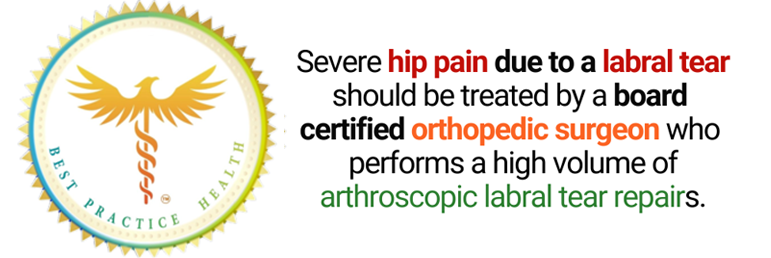
HIP ARTHROSCOPY
A hip labral tear occurs in a ring of cartilage spanning the outside rim of the hip joint socket. Labral tears of the hip can cause pain or stiffness in the hip or groin as well as a clicking, locking, or “catching” sensation in the hip joint.
Our surgeons use hip arthroscopy to diagnose and repair labral tears.
Hip arthroscopy is a minimally-invasive surgical technique used to diagnose and treat a variety of conditions affecting the hip joint that don’t respond to more conservative approaches. During hip arthroscopy, a few small incisions are made to accommodate a long, slender camera (arthroscope) and special instruments. A viewscreen allows the surgeon to “see” inside the joint and perform the procedure. The smaller incisions result in less pain and swelling and a faster recovery for the patient as compared with open surgical techniques. Our state-of-the-art orthopedic surgical center has been home to thousands of labral tear repairs performed on patients from all over the world.
Our Surgeons are skilled in a number of hip arthroscopy procedures including:
- Removal of bone spurs
- Dysplasia correction
- Tendon repair
- Hip labrum repair
- Removal of inflamed tissue from synovitis
- Removal of bone fragments or loose cartilage
- Treatment of infections of the hip joint
Arthroscopic Surgical Treatment of Labral Tears of the Hip
A torn hip labrum can now be repaired through the arthroscope.
The labrum is a thick band of cartilaginous tissue that forms a sleeve around the hip. In addition to helping buffer force, the labrum helps hold the ball in the socket.
Labral tears in the hip cause a sharp pain that usually radiates to the groin. The pain is present most of the time right after injury, and is less frequent after a few months. This is in contrast with arthritis, which starts small and grows, and is associated with loss of range of motion and worsens with age. A labral tear will often produce a click when walking.
No. Labral tears usually do not heal themselves. Small tears can be made not to hurt with rest and by strengthening the muscles around the hip. Larger tears are likely to require intervention. Studies have shown that physical therapy is helpful for a labral tear in 20% of cases; that means 80% of the time it is not effective. If the labral tear is serious then surgical treatment should be considered by a doctor with experience in treating labral tears of the hip. If the tear is left untreated your hip is more likely to develop arthritis, and eventually require total hip replacement.
Yes. But an X-ray may not. X-ray shows bone while MRI shows soft tissue. So, X-ray will not show a labral tear directly. However, x-ray may show bone spurs associated with a labral tear, making it a useful first test. An MRI will show the tear and it’s size directly.
Yes, but only for a short time. Injections are often used to get an athlete through the season. Injections are temporary, and do not change the need for surgery. If the tera is bad enough for surgery, and your schedule permits, then just have the surgery.
Check out the following surgery animation: https://www.youtube.com/watch?v=jlBouvA4yM0



 Subscribe!
Subscribe!




